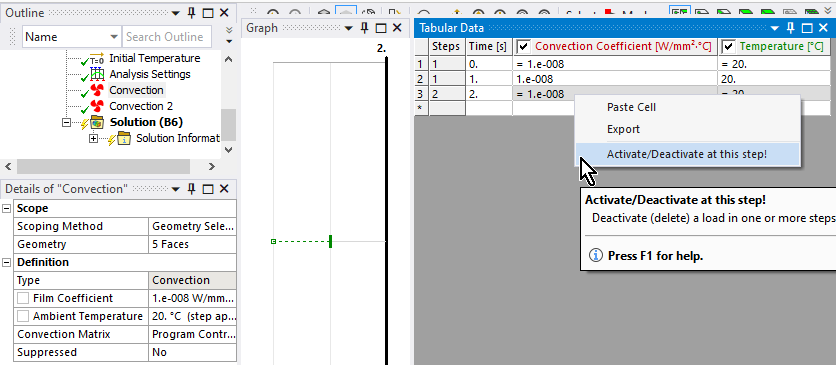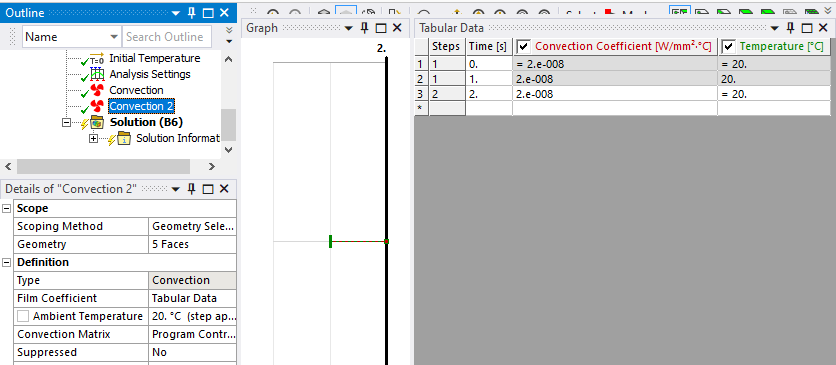TAGGED: boundary-conditions, transient-analysis, workbench
-
-
November 14, 2021 at 9:03 am
mahendert2015
SubscriberI am trying to do a Transient thermal (TT) analysis in an ANSYS workbench with two convection boundary conditions. The film coefficients in two convection boundary conditions are functions of temperature. When I tried to apply two convection boundary conditions, it's taking both at a time. I tried to simulate by taking two transient thermal analyses and trying to import the results from one convection to the other but in the second TT, the initial temperature is enabled and starting the analysis by taking that initial temperature into consideration.
Is there any way to do this kind of simulation where two convection boundary conditions need to apply in which film coefficient is a function of temperature?
November 14, 2021 at 1:31 pmNovember 14, 2021 at 3:16 pmmahendert2015
SubscriberThank you for your quick response.
I did that option but I need to apply the two BC's in which the convection film coefficient is a function of temperature, not time. Aslo, I need to apply one convection BC at time period of 0 to 50 sec and another convection BC from 50 to 100 sec.
If possible could you check this and reply.
November 14, 2021 at 4:26 pmpeteroznewman
SubscriberI expect with some APDL code, you can implement temperature dependent convection. Hopefully, someone who knows how to do this will respond.
In the Mechanical APDL reference section is the MP command, which is used to define a temperature dependent material property, including Convection film coefficient.
There is an element LINK34 which can be used to convect heat from one node to another.
What is the physics behind the temperature dependent convection film coefficient?
What is the fluid that is convecting the heat away?
Another approach is to build a CFD model in Fluent and model the convective fluid flow. Temperature dependent properties can be used in Fluent.
By building a CFD model, you no longer need a convective film coefficient, the model will convect the heat using fluid motion.
/forum/discussion/8778/convection-question
November 14, 2021 at 4:57 pmmahendert2015
SubscriberThank you once again.
I have a material that is cooled in the air for some period of time and then cooled in water for another period of time. I have data of film coefficient as a function of the temperature of both fluids (air and water). I need to find the thermal stresses developed during the cooling of the material.
I think thermal analysis coupled with structural analysis is sufficient. The problem I am facing is not able to apply two BC's one after the other.
Any suggestion on this.
Thanks in advance.
November 14, 2021 at 7:03 pmpeteroznewman
SubscriberMy first post shows how to apply two different Convection BCs, the first is active from 0 to 1 sec in Step 1, then becomes inactive in Step 2 that ends at 2 sec. The second Convection BC is inactive in Step 1 and active in Step 2. Both Convection BCs are applied to the same surfaces. Simply change the end time of Step 2 to 100 sec and the end time of Step 1 to 50 sec and you have what you want, assuming you have some APDL code to create the temperature dependent material properties for each BC.
Viewing 5 reply threads- The topic ‘I am not able to apply two convection boundary conditons at different time intervels.’ is closed to new replies.
Innovation SpaceTrending discussionsTop Contributors-
4613
-
1530
-
1386
-
1209
-
1021
Top Rated Tags© 2025 Copyright ANSYS, Inc. All rights reserved.
Ansys does not support the usage of unauthorized Ansys software. Please visit www.ansys.com to obtain an official distribution.
-













